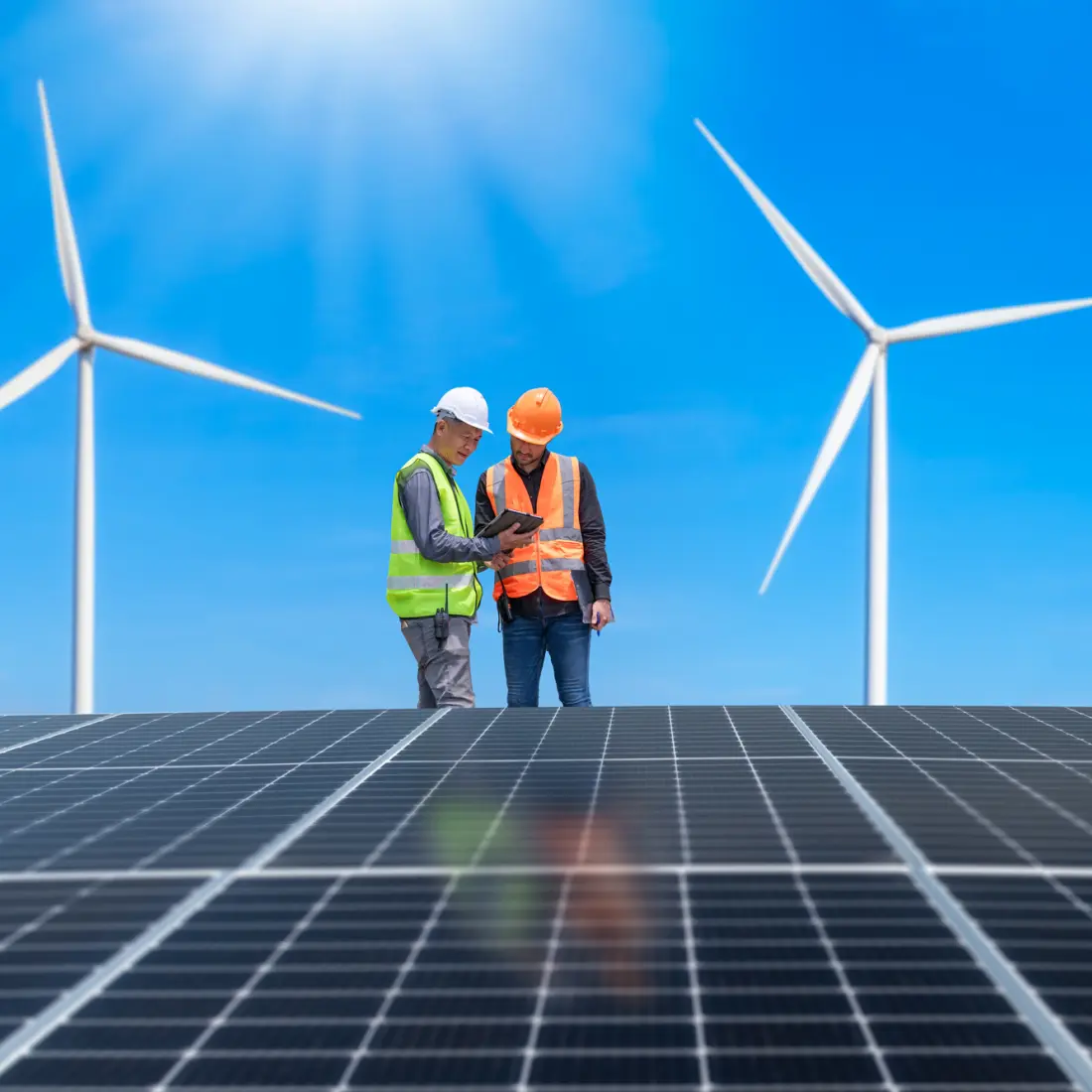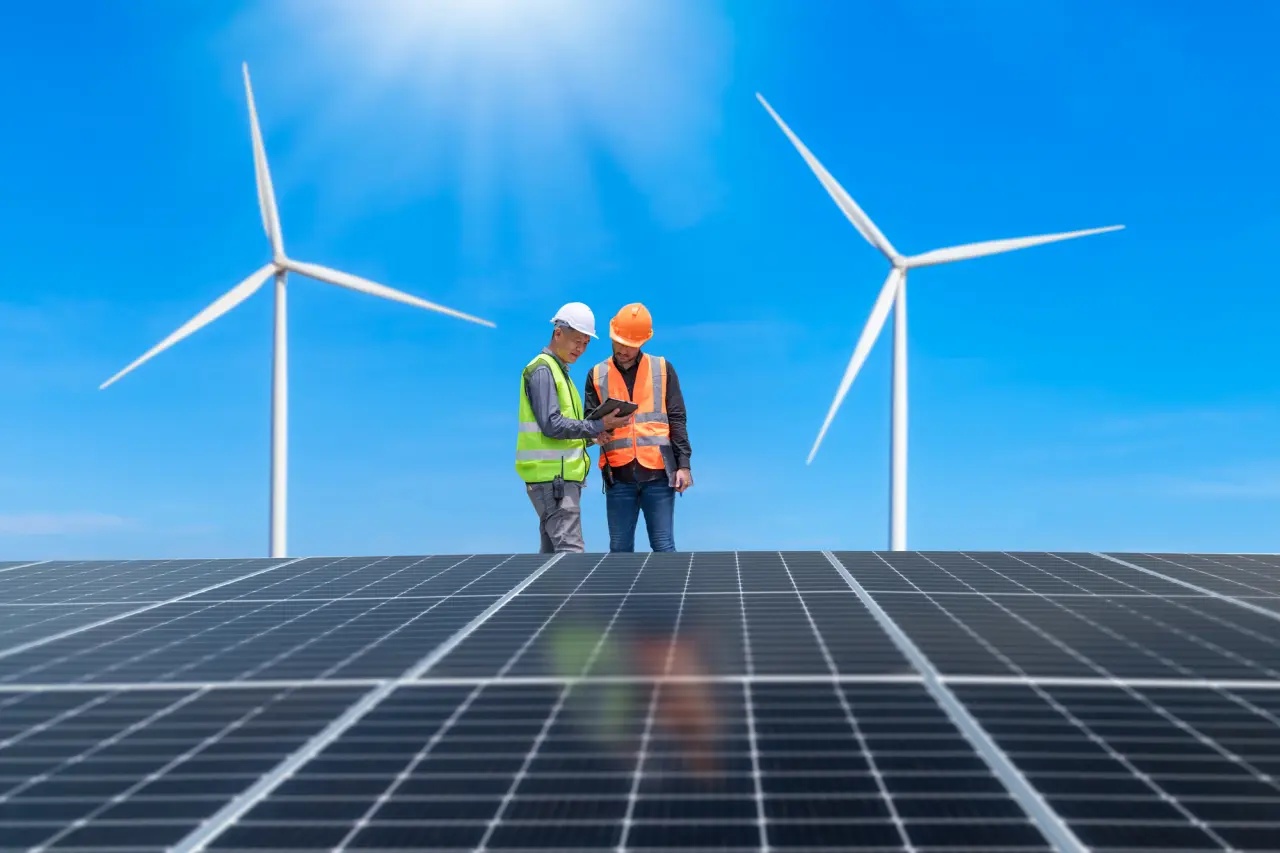Solar energy vs. wind energy. Pros and cons


Solar and wind energy are both growing in popularity because they are excellent sources of carbon-free electricity. Wind turbines harness kinetic energy, which gets turned into electricity and stored or fed into the grid. Solar panels contain photovoltaic (PV) cells that turn radiation from the sun into electricity for direct use, storage, or feeding power into the grid.
According to the U.S. Energy Information Administration (EIA), solar and wind are the fastest-growing energy producers in the country. Together with other renewables like hydroelectric power, they’re approaching — but not yet overtaking — natural gas as the largest energy source in America.
Both wind and solar have positive attributes in terms of energy generation. Each has a different set of drawbacks. If you are searching for a new source of clean energy, it's important to understand the advantages and limitations of both renewables.
What is solar power?
Solar energy systems consist of photovoltaic (PV) panels. Each panel has many solar cells arranged in rows. These cells absorb sunlight and convert it into direct current (DC) electricity. This electricity is then converted into an alternating current (AC). This process happens without fossil fuels, making solar a clean energy source.
You usually see residential solar systems on rooftops and larger arrays (rows of panels) mounted on the ground in open fields. The efficiency of solar panels has improved significantly over the years, making them a viable option for providing power to homes and commercial buildings.
Pros of solar power
Solar power brings some advantages compared to other energy sources. It’s renewable and cost-effective once you invest in the panels. Also, the systems are easy to maintain over their lifespans.
Renewable energy source
Solar power is a renewable energy source because it relies on the sun, which rises and sets every day. This frees you from relying on finite energy sources like natural gas.
A related advantage is solar power's ability to generate electricity without producing harmful emissions. Solar panels do not emit GHGs when producing energy. Solar power’s carbon footprint is limited and only includes emissions from making and transporting the panels.
The physical footprint of solar is also limited since most systems are on rooftops or frames above the ground.
Cost-effective
In recent years, the cost of installing solar power has significantly decreased, making it a more affordable option for homeowners and businesses.
Additionally, the introduction of community solar programs has further expanded accessibility. These initiatives allow individuals who cannot afford panels or don't have space for them on their property to benefit from solar power.
There are various financing options for those who want residential or commercial solar. You can choose from leasing agreements, power purchase agreements (PPAs), and loans tailored specifically for solar installations to spread payments out over time.
Low maintenance
One of the major benefits of solar panels is the low maintenance requirements. They don't have any moving parts, so there’s no risk of mechanical failure. Their simple design allows them to keep functioning for 20 to 30 years without much care.
Most solar power systems only need periodic inspections and occasional cleaning. This routine maintenance involves checking the panels for dirt, debris, or shade and cleaning or making adjustments if needed.
Cons of solar power
Solar panels bring significant advantages, but you should be aware of their limitations and potential drawbacks. These include the need for sunny weather for full efficiency, space requirements, and decreasing performance due to age.
Weather dependence
Solar panels always produce power from both direct and indirect sunlight. This means they can still give you electricity with cloud cover. However, the amount of energy they make depends on the sunlight they receive. Output will be lower on cloudy days.
Site selection and orientation are crucial for avoiding this issue. Software can quickly assess sites for factors like sun exposure and weather patterns. Such tools can help you maximize exposure to direct sunlight to ensure maximum output.
Limited space
Solar panels take up space. For many homeowners, the solution is to put the panels on the roof. However, there are some potential issues with this approach. First, shade or roof orientation can limit sun exposure. In cities, other structures can block sunlight.
Ground-based arrays are alternatives for people with a lack of roof space. If you have land without shading, you can use ground-mounted systems to get more flexibility in terms of panel placement.
Solar degradation
Solar panels have long lifespans, but they degrade over time. On average, solar cells decrease in efficiency by about 0.75% per year. However, the degradation can be worse in extreme climates.
Understanding the rate of solar panel degradation is essential for planning the long-term performance of your system. Proper panel and system orientation can maximize efficiency and limit the impact of degradation.

What is wind energy?
Wind turbines use large blades that capture wind movement. As the wind blows, the blades rotate, and the turbine's interior mechanism converts kinetic energy into mechanical energy. The system also has a generator that turns the mechanical energy into electrical power.
Wind energy has gained popularity due to its sustainability and efficiency. In 2023, wind turbines in the U.S. produced 425,235 gigawatt-hours (GWh) of electricity. That's enough to power roughly 39 million homes.
Turbines are also very flexible in terms of placement. They can be installed on land or offshore, making them ideal for commercial or utility-scale use.
Pros of wind energy
Wind energy is popular for a reason. Its major advantages include high output, low overall cost, and eco-friendliness.
Here’s a closer look at these benefits.
High power output
Modern wind turbines are capable of generating a significant amount of energy compared to previous iterations. Today's turbines are capable of producing 375% more electricity than those built in 1999 and 5% more than turbines installed in 2022. Wind customers can potentially get more energy with fewer turbines, decreasing the upfront cost of installation.
Lower electricity costs
Like solar, wind energy can lower electricity costs over time because it doesn't rely on traditional fuels that you need to input. For homes and businesses, turbines can also limit reliance on the grid, reducing utility costs.
Also, utility-scale wind systems are becoming cheaper and turbines are getting larger and more efficient. Power companies can pass these savings on to consumers.
No pollution
Like solar power, wind energy does not rely on fossil fuels, so it doesn’t produce carbon emissions. This absence of pollution helps improve air quality locally and reduces the overall carbon footprint for your home or business.
Cons of wind energy
Wind energy does come with some important drawbacks that you need to consider. Some locations don’t work for wind power, and turbines require ongoing maintenance. Also, turbine operation can negatively impact both people and animals.
Here’s a closer look at these potential drawbacks.
Location dependence
Wind turbines require specific locations with consistent and strong winds to operate effectively. Areas with steady wind patterns — such as coastal regions, open plains and highlands — are ideal for harnessing wind energy. If you live in an area without consistent wind, turbines may not produce enough energy to be a worthwhile investment.
Cost and maintenance
The initial cost of wind turbines can be steep. This upfront investment includes the purchase of the turbine and installation. The price tag depends on the size of the turbine, with the Department of Energy putting the cost between $850 to $950 per kilowatt (kW).
Wind turbines also have more mechanical components, so they require more maintenance than solar panels. This extra care can add to the overall cost of ownership.
Environmental impact
While wind energy is a clean power source, wind turbines can negatively impact local wildlife and ecosystems. The spinning turbines can disrupt flight patterns and migration paths for birds, which can sometimes hit the turbines while in flight.
Additionally, turbines can be loud when in operation. The noise can affect people and animals in the local area, disrupting ecosystems and affecting the quality of life for residents.
Wind turbine vs. solar energy: Which is better?
The question of whether wind turbines or solar energy is better ultimately depends on your circumstances and energy needs. Both options have unique advantages and challenges. You need to consider factors like climate, space, budget and energy use patterns to find the best choice for your needs. For instance, a turbine may work better in an area with consistent wind, while solar is preferable in regions with fewer overcast days.
Bottom line
Both solar and wind energy are clean power sources that don't expose you to the pollution and ongoing cost of fossil fuels. In terms of sustainability and eco-friendliness, you can't go wrong with either. You simply need to choose the one with the most advantages and fewest drawbacks for your location.